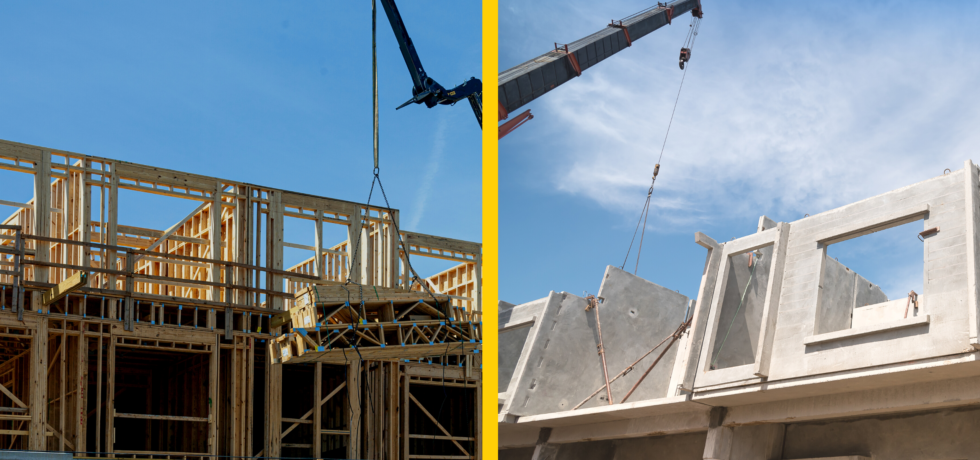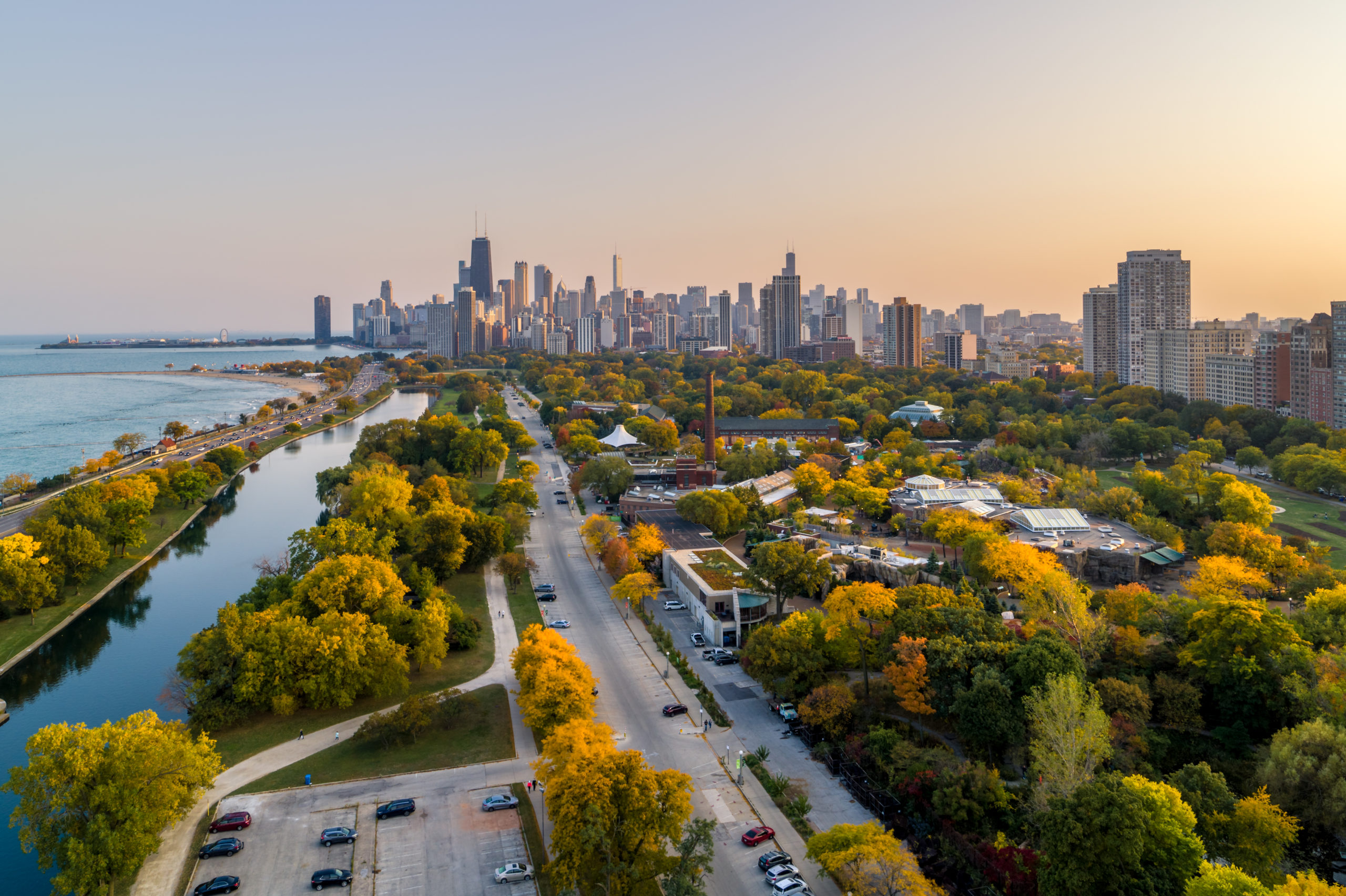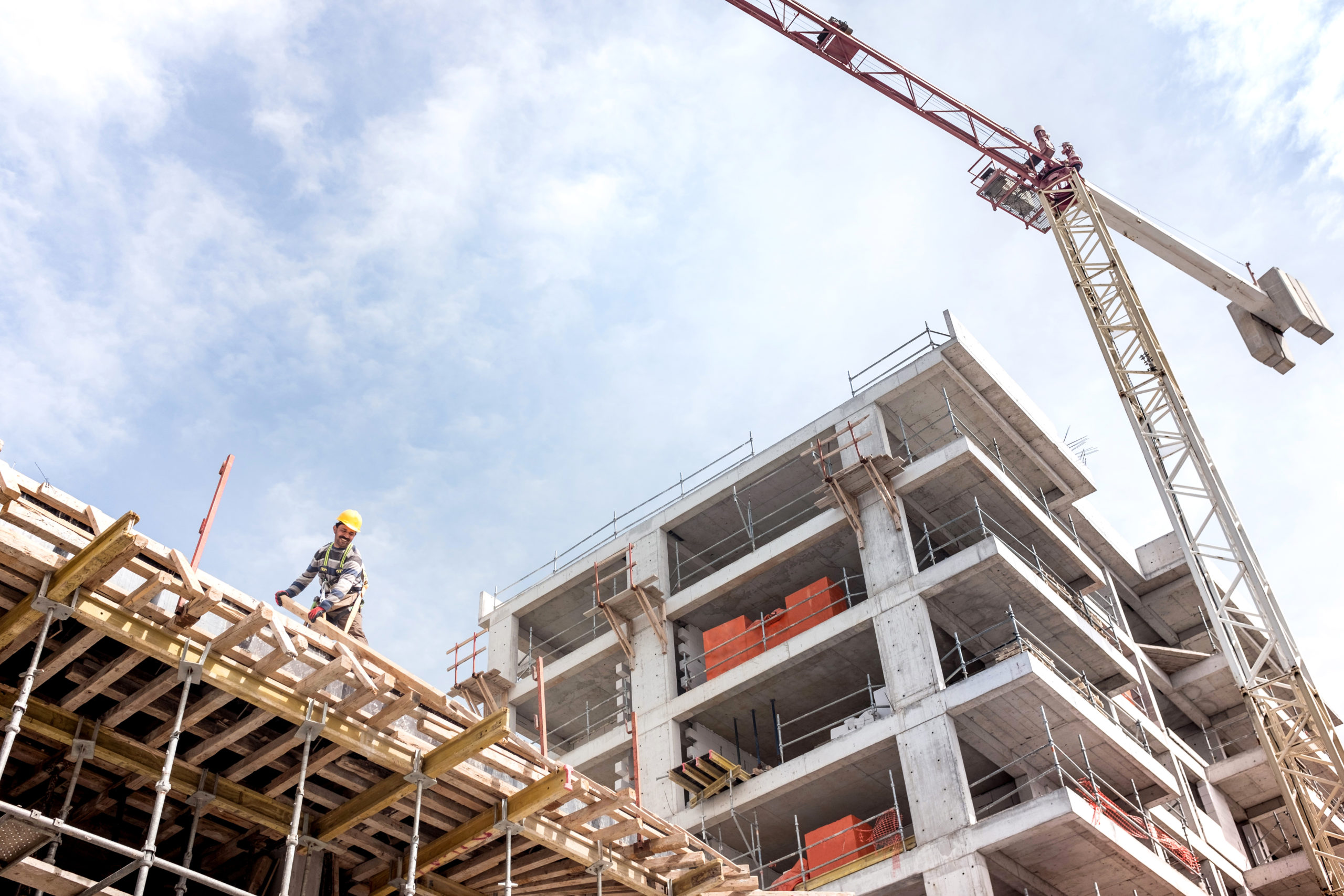Category
- Most Popular
- Sustainable Construction
While many in the construction industry are aiming for net-zero-carbon concrete by 2050, another trend in sustainable building has also grown in popularity: mass timber. Because its emissions aren’t as well calculated like those of concrete or steel construction, a number of builders and designers view it as a more eco-friendly and less carbon-intensive form of building material. What’s more, due to it being made of wood, mass timber is even able to sequester carbon.
All of which makes it seem like the most ideal building material out there with the demand for sustainable construction on the rise. However, it’s not. Like any building material, mass timber has its own downsides.
But if both mass timber and concrete have their pros and cons, how do you decide which building material is right for your project?
A Big Factor in This Decision Will Be Cost
No matter what anyone thinks of mass timber or concrete, the cost of either will play a big role for which gets picked. Unfortunately, comparing the two is a tricky process. After all, the price for any building material will always vary depending on the region you’re in.
Some Signs Suggest Mass Timber May Be a More Expensive Venture
An example of this can be seen in one study conducted by the Oregon State University. It noted that the cost of mass timber construction could be 6.43% higher than concrete construction. The researchers attributed this excess in cost to a higher rate of change orders. But that’s not the only reason. Another study compared the total life cycle cost of mass timber to concrete and found that it had much higher front-end costs. In fact, mass timber’s front-end costs were 26% higher. The two biggest causes for this were the mass timber building’s construction and utility costs.
Still, mass timber could offer some potential cost-saving measures of its own. At least one study shows that it could provide a productivity gain. Despite its noting that mass timber construction does still require more time during the designing phase of a structure, the study also mentioned that it required 30% less construction time. There are a number of reasons for this, including simplified and reduced deliveries and fewer trades on-site.
So if you don’t mind higher front-end costs with a potential for a productivity gain, mass timber might be worth considering.
By Contrast, Concrete Construction May Be More Cost-Effective
If you want to keep your construction costs at a more appealing rate and still have the possibility of expediting your work, concrete will be the better bet. That is likely due to how widespread concrete is. As the second-most consumed material throughout the world, it comes with more professional acceptance and variety. That makes it less costly to acquire and easier to modify for quicker, better building.
Another Factor Will Be the Environmental Impact
Cost isn’t the only big deciding factor in a building material’s selection of course. With the increase in demand for sustainable, climate-resilient buildings, the construction industry has now put an almost equal amount of importance on the environmental impact of a material.
Mass Timber Is Not as Eco-Friendly as Many Make It Out to Be
Many feel that mass timber is the better option when it comes to sustainable construction. But doing a thorough comparison of just how much impact mass timber has to concrete is not as simple as it seems. For one, the industry is still looking into the mass timber life cycle. There are no clear answers on just how well it performs yet. It doesn’t help that international guidelines are not very strict when it comes to letting countries define activities when calculating carbon emissions for the forestry sector. In some cases, that’s led to many megatonnes of uncounted carbon emissions in regions like Canada and millions of tonnes in regions like North Carolina. And what’s more, mass timber construction has its own sustainability threats to worry about.
It’s true that it doesn’t make use of cement like concrete, which is a very carbon-intense material. And it’s also true that trees are able to absorb and store CO2 emissions, which is also a temporary benefit when they become timber.
But encouraging builders to take advantage of either benefit could very well pose a much greater carbon concern in the end. All it takes to see why is to look at the State of Oregon’s forestry industry. It’s a large-scale industry there that has only increased its logging. That will likely increase further as demand for it grows, and that in turn will promote the planting of fast-growing trees. It doesn’t sound so bad until you consider the end result of this, which is a biological desert. With the area being frequently logged, there is no real room for other life to flourish there, leading to a very real possibility of mass extinction. Even worse, this logging process can still be a heavy carbon emitter. Oregon’s own forest products industry is already the largest source of CO2 emissions in the area.
And Concrete Doesn’t Have to Be So Carbon-Heavy
Concrete, as alluded to earlier, is also not great when it comes to carbon emissions. It’s why so many are trying to see if materials like mass timber will turn out to be a better alternative.
But people often forget that concrete is versatile. There are many ways to reduce its lifetime carbon footprint. Some of which include the following:
- Replacing the use of petroleum-based membranes with non-toxic waterproofing admixtures
- Using aggregates of at least 20 mm (0.79 in) in size to reduce the amount of cement used
- Increasing concrete durability without extra cement or toxic silica dust via Hard-Cem®
- Substituting cement clinker with cementitious materials to lower carbon emissions
This isn’t an exhaustive list, but it shows that concrete doesn’t have to be seen as a negative for sustainable construction. It just needs to be handled with best green practices in mind.
But You Also Have to Consider the Resiliency of Your Materials
So far, we’ve looked at the cost and environmental sides to mass timber and concrete. But we have yet to look at their resiliency, which is just as important. Without the right resiliency, a construction project isn’t worth its cost or its promised sustainability. After all, if it doesn’t stay standing in the current volatile environments we have today, it becomes a much less sustainable prospect and wastes what money was spent on its construction.
To avoid that, builders try to ensure their project materials are not just high-quality but also capable of resisting potential environmental hazards for a long period of time.
But what does that look like for mass timber and concrete construction?
Mass Timber Still Has Some Durability Concerns That Need to Be Considered
Despite the massive interest in the potential for sustainability in mass timber, the material’s resiliency does not garner the same appeal. Instead, many often list concerns about the potential threats to the material’s durability.
Two of the biggest revolve around its resistance to fire and water.
That first concern might sound like it’s conflating mass timber construction with any old wood construction. But while the two don’t have the exact same fire concerns, they are both still vulnerable. Mass timber just happens to come with better fire resistance. That is especially the case when given a fire retardant coating. But even without the coating, it responds to fire by charring, which for a length of time, can protect the interior from damage. That in turn can slow down the collapse of a burning mass timber structure.
But that does not make it immune to fire. It’s still a combustible material. In fact, according to the National Fire Protection Association, timber elements add to the fuel load of a structure, increasing the initial fire rate.
That is especially important to remember when tall mass timber construction is just underway. At that time, there are no sprinkler systems and likely no fire-resistant coatings in use just yet. With both that and its extensive size, it leaves room for potential significant fire hazards toward nearby structures if the mass timber structure catches fire, which has organizations like the Alberta Professional Fire Fighters & Paramedics Association concerned.
What’s more, the fire-rated assembly details for this material have yet to be fully standardized, leaving possible quality concerns.
The risk of water ingress is no less concerning. Engineered wood like mass timber can easily hide signs of that for years. That can lead to significant property damage and interfere with the material’s ability to withstand vertical and lateral loads.
Even if builders find ways to manage this risk and the risk of fire well enough, they’ll still have similarly serious durability concerns with mass timber’s vulnerability to decay, mold, and termite attacks.
Meanwhile, Concrete Is Known as One of the Most Durable Materials Out There
There’s a reason concrete remains a popular building material, and it’s not just because it’s easily accessible worldwide. For centuries, it has proven itself to be a highly resilient material. It can withstand fire, severe weather, rot, and insects with relative ease.
Though, it does still share mass timber’s weakness to water.
Luckily, over the years, builders have come up with plenty of solutions for this issue. Some of the best involve full waterproofing systems. These protect not just the concrete itself but its surrounding structure as well. For the concrete’s protection, these often involve the use of a crystalline waterproofing admixture like our Krystol Internal Membrane™ to ensure the concrete can chemically react to water to block it out and self-seal micro-cracks. Then, to protect the rest of the structure, additional tools like our Krystol® Waterstop System are used, ensuring joints, penetrations, tie holes, and more are kept safe and dry from water ingress.
That Will Impact the Overall Cost of Insurance for a Structure
Risk is everything to insurance companies. Without an understanding of it, insurance companies can’t estimate just how much they’ll be covering overall and whether that’ll be a profitable venture for them. So the number and severity of risks a building material has will no doubt impact how well the material is received by such companies.
To that end, mass timber is at a significant disadvantage. Due to its many vulnerabilities, most insurance companies are understandably more cautious around the material.
That can lead to some frustrating barriers for general contractors. For example, some insurance companies will likely insist on capacity limits, which forces contractors to work with multiple insurers to properly cover a project. It’s a costly move for the contractor. It’s not the only one either as a number of insurance companies in general tend to increase their coverage prices when it comes to mass timber construction.
With All These Aspects in Mind, It May Be Better to Stick with Concrete
Despite concrete’s own very real carbon concerns, it still remains our best solution for low-risk, sustainable construction. Compared to mass timber, it is more accessible, doesn’t lead to excessive logging, remains highly resilient, and comes with fewer insurance concerns. But more importantly, it is very versatile, making it possible to significantly reduce its lifetime carbon footprint. That gives builders the best of both worlds: an accessible, durable building material capable of creating long-lasting structures that can be modified to leave a smaller impact on the environment.









